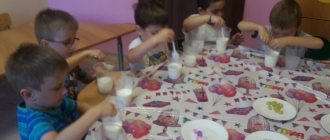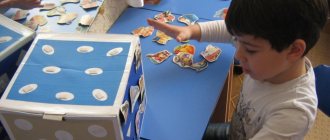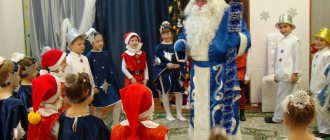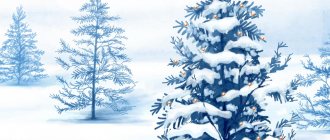Water coloring
Target
: Identify the properties of water: water can be warm and cold, some substances dissolve in water. The more of this substance, the more intense the color; The warmer the water, the faster the substance dissolves. You will need containers of water (cold and warm), paint, stir sticks, and measuring cups.
An adult and children examine 2-3 objects in the water and find out why they are clearly visible (the water is clear). Next, find out how to color the water (add paint). An adult offers to color the water themselves (in cups with warm and cold water). In which cup will the paint dissolve faster? (In a glass of warm water). How will the water color if there is more dye? (The water will become more colored).
How to push water out?
Target:
Form the idea that the water level rises if objects are placed in the water.
You will need a measuring container with water, pebbles, and an object in the container. The children are given the task: to get an object out of the container without putting their hands in the water and without using various assistant objects (for example, a net). If the children find it difficult to decide, then the adult suggests putting pebbles in the vessel until the water level reaches the brim. Conclusion: the pebbles, filling the container, push out water.
Assistant water
Target:
use knowledge about rising water levels to solve a cognitive problem.
You will need a jar with small light objects on the surface, a container with water. Cups.
The children are given the task: to take objects out of the jar without touching them with their hands (pour in water until it flows over the edge). The adult offers to do these actions. Children conclude: when water fills a container, it pushes out the objects inside it.
How the water went for a walk
Target:
give an idea that water can be collected with various objects - a sponge, a pipette, a bulb, a napkin.
You will need a foam sponge, a plastic syringe without a needle, a rubber bulb, and a bath of water.
They poured some water into the basin and forgot about it. After a while, the water girl got bored: “I’m sitting here and I don’t see anything, but there are probably so many interesting things around!” “She wanted to get out of the basin, but it didn’t work - the water doesn’t have arms or legs. She wanted to call someone, but the voice of the water in the basin was quiet - no one heard her. And then my mother came and thought: “Why is there water standing here? "Took it and poured it into the sink. Water flowed through the pipes and ended up in a large river, in which there was a lot of other water. And our water flowed along with the big river through the city, past beautiful houses and green gardens. “How beautiful, how wonderful! - thought the water girl. “If I were sitting in my basin and wouldn’t see this beauty!” »
Take a foam or other absorbent sponge, a rubber bulb and a plastic syringe (without a needle). Pour water into a small basin, prepare several empty containers (cups, bowls, etc.). Ask your child to dip the sponge in water and show how to squeeze it into the cup. Then take the water with a rubber bulb and pour it into another container. Do the same with the syringe.
A piece of ice is melting
Target:
introduce what freezes in the cold and melts in the warmth.
You will need a candle, spoon, ice, transparent glasses with hot and cold water.
One winter, a little squirrel brought home a piece of ice, an icicle, he left it in a hollow, on the floor in the hallway, and he went to have dinner and then sleep. When I woke up, I immediately remembered about the piece of ice and ran into the hallway. The piece of ice was gone - nowhere to be found, but there was a glistening puddle on the floor.
Put a piece of ice on a spoon and heat it over the candle flame: “Look, here is ice. Let's heat it up on the fire. Where is the ice? Melted! What did the ice turn into? In the water! »
Pour hot water into a transparent glass mug or glass (it can be tinted, put in a piece of ice and watch how quickly it melts. You can take several glasses and watch how ice melts differently in water of different temperatures.
Soap bubbles
Target:
create a desire to blow soap bubbles, introduce the fact that when air gets into soapy water, a bubble forms.
Material:
soapy water, cocktail straws, bottles with the bottom cut off, helium pen body.
Progress of the game - experiment
Artistic word
Vodichka doesn’t like slobs and dirty people,
Seething and swearing: “Glug-bul-bul-bul! “But if we wash our hands and faces, Vodichka is happy and is no longer angry.
Lather your hands until you get a lush, thick foam. Then separate your palms so that a thin transparent soap film forms between them. Blow on it and you will get a soap bubble. Let the child blow on the soap film in your palms, help him make his own soap bubble. To encourage your child to blow soap bubbles on his own, offer him, in addition to a frame from a purchased bubble, a variety of tubes - a cocktail tube, a plastic bottle with the bottom cut off, or roll and glue a thick tube from thick paper. To get a solid tube (kids often bite or bend cocktail tubes), you can disassemble the helium pen and take the body from it - a transparent plastic tube.
You can make your own bubble water using dishwashing liquid.
Progress of the game - experiment
Artistic word
In the summer, after rain, a bright rainbow appeared in the sky, she looked down at the ground and saw a large smooth lake there. Rainbow looked into it as if into a mirror and thought: “How beautiful I am!”
.
Then she decided to swim in the warm lake. Like a huge multi-colored ribbon, a rainbow fell into the lake. The water in the lake immediately turned different colors: red, orange, yellow, green, blue, indigo and violet. The kids came running with brushes and albums, dipped their brushes into the water and painted pictures .
The rainbow had plenty of fun and flew away beyond the clouds. The water in the lake became clear, and the kids brought home beautiful and bright drawings. Rainbows in water don't only happen in fairy tales. For example, you can color the water with paints, invite your child to dip his finger in the red paint, and then lower it into a glass of water. Do the same with the other colors one by one. You will get seven cups corresponding to the colors of the rainbow.
A piece of ice is melting
Purpose: to introduce what freezes in the cold and melts in warmth.
Materials: candle, spoon, ice, transparent cups with hot and cold water.
Counting table
Target:
introduce the properties of water: it flows, it moves. You will need a bath of water and toys.
We cook porridge for the kids,
(Twirl the handle in the water, as if “stirring porridge.”)
We make dough for crumpets,
(Knead the water like dough.)
We treat you to sweet tea,
(We collect water in our palms and pour it back into the bath.) Well, after that, we relax! In the bath - splash!
Invite the children to play with water, pay attention to the fact that the water moves in the direction of movement of their hand, and it also shimmers and flows.
Progress of the game - experiment
Artistic word
One day the bunny decided to show his mother a trick. He placed transparent glasses on the table. Then he poured water into them. Water flowed gurgle-glug.
- Mom, close your eyes! - said Bunny.
Mom closed her eyes and began to wait for what would happen. (And close your eyes)
.
- Open up! - Bunny commanded.
When mom opened her eyes, she saw that the water in the glasses was no longer plain, but multi-colored - yellow, red, blue, green and orange. (And you show with your finger which one is which)
.
- How beautiful! - Mom was delighted.
Invite the children to prepare multi-colored juice for the dolls, try to attract the child’s attention with an element of magic: “And if we put a brush with yellow paint in a glass of water, I wonder what will happen. What kind of juice is this?”
Set the table, arrange the glasses, seat the dolls, and treat them to drinks. Red water will turn into tomato juice, orange water into orange juice, yellow water into pineapple juice, and blue water into blackberry juice.
A fairy tale about how a rainbow swam in water
Purpose: to introduce the production of intermediate colors by mixing red and yellow, blue and green.
Material: seven transparent cups with warm water, seven colors of gouache paints.
Progress of the game - experiment
Having chosen the moment when the sun is peeking through the window, use the mirror to catch a ray and try to draw the baby’s attention to how the sun “bunny”
jumps on the wall, on the ceiling, from the wall to the sofa, etc. offer to catch the running
“bunny”
.
If the child liked the game, switch roles: give him a mirror, show him how to catch the beam, and then stand against the wall. Try to “catch”
a speck of light as emotionally as possible, while not forgetting to comment on your actions: “I’ll catch you, I’ll catch you!” What a nimble bunny - he runs fast! Oh, and now it’s on the ceiling, out of reach. ... Come on, hare, come down to us!” etc. A child’s laughter will be your best reward.
Who lives in the water
Goal: to develop cognitive interest and imagination.
Material: blue and cyan pencils or watercolors, album sheet
Progress of the game - experiment
Artistic word
Water men
We spent the whole day splashing in the river.
And then they climbed into the basin
Take another swim.
Sandmen live in the sandbox, and in the water (in the sea, in the lake, in the river, as well as in the bathtub and basin)
water men live.
The water men are also very fun to play with. They may look like in the picture .
But you can come up with water men yourself and draw them in an album. Give your child blue and cyan crayons or watercolors and ask him to draw his own water people. Drink delicious juice dolls
Goal: to identify the properties of water and paints, the ability of paints to dissolve in water and change its color.
Materials: watercolor paints, brushes, transparent plastic glasses with water.
Drawing artists
Target:
make you want to draw on a wet sheet, find out that the colors are mixed and do not have a clear boundary, new colors are obtained. You will need a large sheet of watercolor paper moistened with water, oilcloth, paints and brushes.
The sun is yellow in the sky
Red flowers bloom
A fish splashes in the blue sea. Draw it all.
The process of painting with watercolors on a wet sheet can give you an unforgettable experience. To do this, lay an oilcloth on the table and wet a thick sheet of watercolor paper. Dip your brush into one of the paints and gently brush over the paper. Ask the children what will happen if we use other colors. Give the opportunity to play with colors. As if by chance, you can brush over the drawing with just water, without paint - the water will create delicate, blurry, light halftones on the sheet.




